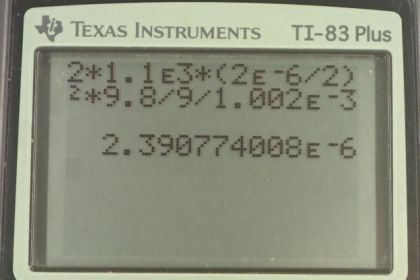Question
Find the terminal velocity of a spherical bacterium (diameter ) falling in water. You will first need to note that the drag force is equal to the weight at terminal velocity. Take the density of the bacterium to be .
Final Answer
Solution video
OpenStax College Physics for AP® Courses, Chapter 5, Problem 27 (Problems & Exercises)

vote with a rating of
votes with an average rating of
.
Calculator Screenshots
Video Transcript
This is College Physics Answers with Shaun Dychko. This bacterium is so small that the drag force will be given by Stokes' theorem because it’s only two micro-meters in diameter, that’s why we know this formula can apply because it’s so small. So that’s six times pi times the radius of the bacterium times the viscosity of the water that it’s going through multiplied by speed. Now when it’s at terminal velocity, it means that this drag force is equal to its weight, and so we can say mg is equal to 6 pi r nu v. And the mass, we need to substitute for that, is going to be the density of the bacterium multiplied by its volume. So that’s the density of the bacterium times four thirds pi r cubed, volume of the sphere, and so we rewrite this formula in blue here but make a substitution for mass, and we have 6 pi r nu v equals density of bacterium times four thirds pi r cubed times g. Then we solve this for v by dividing both sides by 6 pi r nu and this works out to two times density of bacterium times r squared times g over nine times viscosity of water. So this is two times 1.1 times ten to the three kilograms per cubic meter, that’s the density of the bacterium, times by the radius which is two micro-meters divided by two, this was the diameter we were given, so we have to divide by two to get the radius, and then square that result, times 9.8 divided by nine times 1.002 times ten to the minus three pascal seconds, which is the viscosity of water given in Table 12.1, water at 20 degree Celsius, I’m just assuming that that’s the temperature this water’s going to be. And this will work out to 2.39 times ten to the minus six meters per second.
